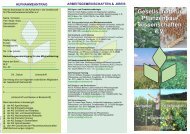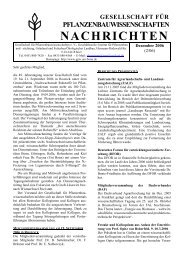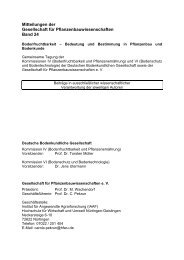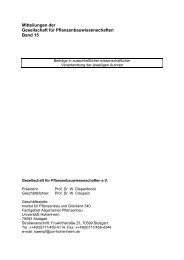Mitteilungen der Gesellschaft für Pflanzenbauwissenschaften Band 23
Mitteilungen der Gesellschaft für Pflanzenbauwissenschaften Band 23
Mitteilungen der Gesellschaft für Pflanzenbauwissenschaften Band 23
Sie wollen auch ein ePaper? Erhöhen Sie die Reichweite Ihrer Titel.
YUMPU macht aus Druck-PDFs automatisch weboptimierte ePaper, die Google liebt.
Mitt. Ges. Pflanzenbauwiss. <strong>23</strong>: 43–44 (2011)<br />
Processes and drivers of N2O emissions from soils<br />
after application of organic fertilizers such as biogas residues<br />
Mehmet Senbayram 1,2 , Jan Reent Köster 1 , Karl H. Mühling 1 and Klaus Dittert 1,3<br />
1 Institute of Plant Nutrition and Soil Science, Christian-Albrechts-University Kiel; 2 Present address:<br />
Hanninghof Research Center, Yara GmbH & Co. KG, Dülmen; 3 Present address: Plant Nutrition and<br />
Crop Physiology, Department of Crop Sciences, University of Göttingen. E-Mail:<br />
khmuehling@plantnutrition.uni-kiel.de<br />
Introduction<br />
Greenhouse gas (GHG) emissions during agricultural production of energy crops are<br />
a serious constraint to one of the central aims of bioenergy production: reducing CO2<br />
emissions by reducing fossil fuel consumption. The biogas fermentation process<br />
produces substantial amounts of fermentation effluents, also called biogas residues<br />
(BGR), that may serve as nutrient source for agricultural production but that are also<br />
a new source of GHG emissions. Therefore the present study aimed at evaluating<br />
favorable biogas crops (maize, wheat and grassland) in two agro-ecological regions<br />
of Northern Germany for their productivity and their environmental impact. We<br />
focused on nitrous oxide, carbon dioxide, and methane fluxes from soil with various<br />
rates and types of nitrogen fertilizers. The objectives of our study were i) obtaining<br />
year-round trace gas flux data of biogas crops, and ii) evaluating effects after<br />
application of biogas residues as manure in comparison to other organic and mineral<br />
fertilizers. Attribution of nitrous oxide (N2O) emission to organic and inorganic N<br />
fertilizers requires un<strong>der</strong>standing of how these inputs affect the two biological N2O<br />
generating processes, i.e. denitrification and nitrification. Therefore, we setup three<br />
additional pot trials in or<strong>der</strong> to study these relationships.<br />
Materials and Methods<br />
A two-year field experiment was conducted at two sites with different soil type and<br />
soil fertility but similar temperate maritime climate (ø 684 mm, 9.0°C). Site one was<br />
characterized by its Luvisol soil with sandy loam texture and the soil type at the<br />
second site was a gleyic Podzol <strong>der</strong>ived from glacio-fluvial deposits of the last<br />
glaciation with a texture being dominated by sand. As silage maize is currently the<br />
standard crop grown for biogas fermentation purposes, we compared silage maize to<br />
alternative bioenergy-crops. Thus at site one, we evaluated trace gas fluxes from<br />
silage maize and wheat (whole crop) - Italian ryegrass (catch crop) rotation that was<br />
grown in parallel plots (12 x 12 m) with both main crops in both years. At site two,<br />
maize monoculture was compared to a four-cut silage grass system. We evaluated<br />
three levels of nitrogen fertilizer rates (0, 120, 360 kg N ha -1 for maize and wheat; 0,<br />
160, 480 kg N ha -1 for grassland), with the highest level - chosen for modeling purposes<br />
- being clearly beyond recommended rates. Three forms of fertilizers/manures<br />
were given: calcium ammonium nitrate, cattle / pig slurry, biogas residue. Fertilizers<br />
were applied in 2 to 4 split dressings. In the pot experiments, we compared mineral N<br />
(ammonium sulfate) and biogas residues for their effects on N2O fluxes using either<br />
stable isotope labeling or N2O isotopomer measurements for differentiation of nitrification<br />
and denitrification-<strong>der</strong>ived N2O emission. In another experiment we tested the<br />
effect of more than 40 years of organic fertilizer application on the denitrification<br />
potential of soils and the denitrification product stoichiometry (N2O / N2 ratio) by using<br />
an anoxic incubation system.







